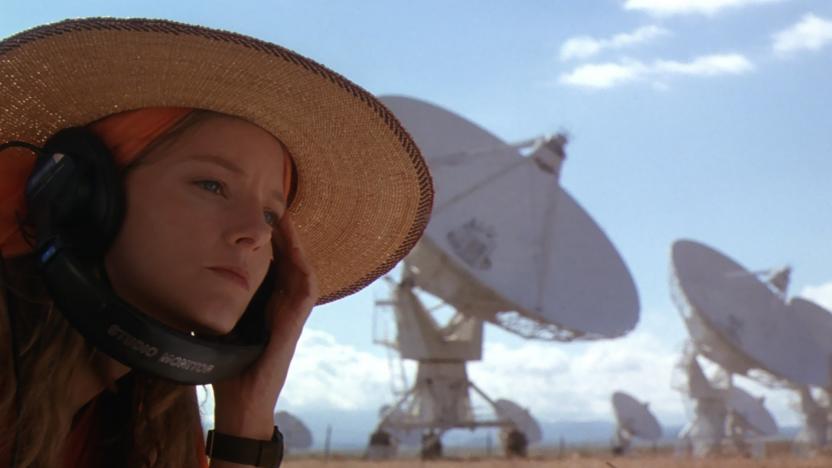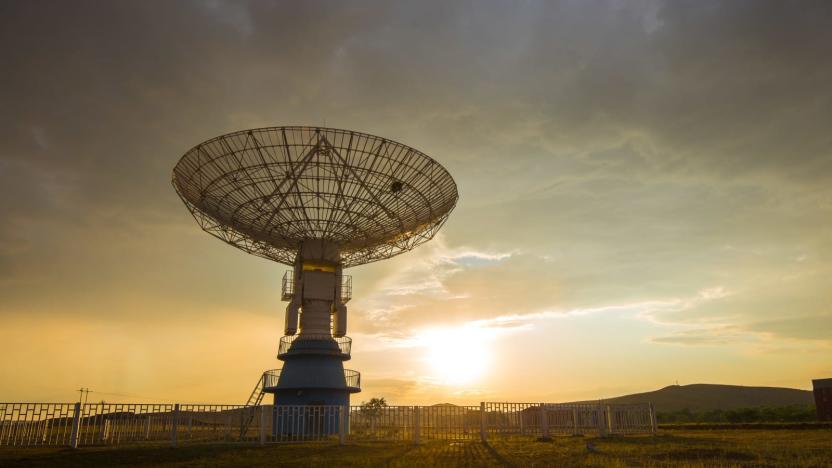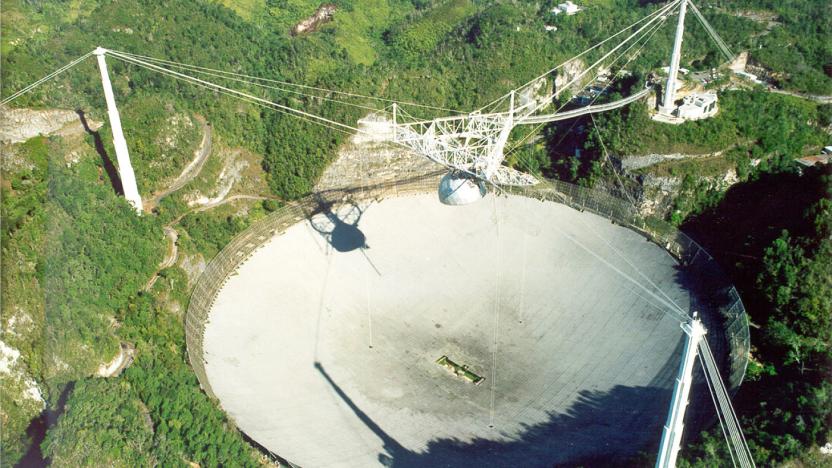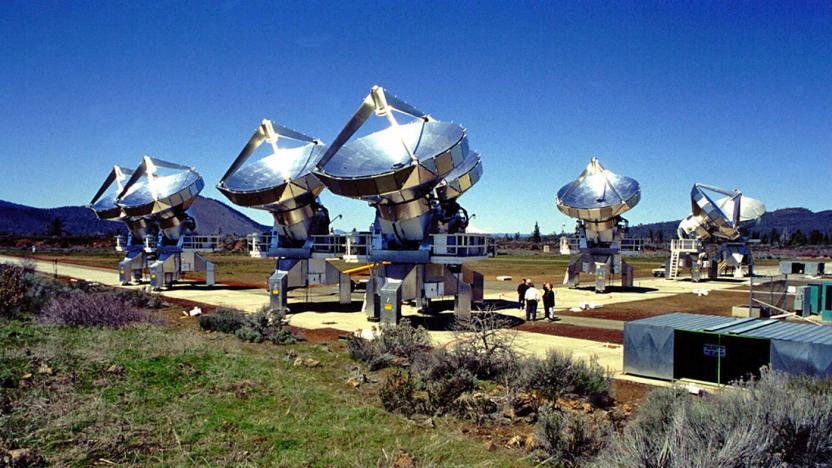SETI
Latest

Hitting the Books: What exactly did Jodi Foster hear in 'Contact'?
As Naomi Pequette argues in her essay "The Sounds of Contact" as part of The Science if Sci-Fi Cinema collection, being "based on a true story" doesn't exactly mean we're getting the whole story.

Without the Arecibo telescope, our search for intelligent life is hamstrung
Structural engineers and repair crews have done all that they can but the end result is as we feared: the Arecibo radio telescope has to come down. The venerable space observatory has been out of commission since August when a cable atop Tower 4, which supports the platform, snapped and gutted a 100-foot long section from the telescope’s reflecting dish. At the time, the University of Florida, which runs the facility on behalf of the National Science Foundation, deployed three different engineering teams to investigate the problem.

How to guesstimate the number of alien civilizations in a galaxy
“Before Drake's work, this question would have seemed to be beyond the realm of scientific inquiry,” Westby told Engadget. fp is the fraction of those stars that have planets. fl is the fraction of those planets that actually do develop life at some point.

China's giant radio telescope will start searching for aliens in September
China's FAST radio telescope will join the search for signs of extraterrestrial life in September.

SETI@Home ends its crowdsourced search for alien life after 21 years
The Search for Extra-Terrestrial Intelligence is a series of projects that scrub the background noise of the universe to look for alien life. One of the most famous ventures under the name was SETI@Home, in which members of the public were encouraged to donate their idle computing time to the venture. After 21 years, however, UC Berkeley has announced that the project will stop on March 31st.

Breakthrough searches for signs of alien life in ultra-fast light pulses
Internet investor Yuri Milner's search for extraterrestrial life now includes a hunt for, effectively, interstellar Morse code. Breakthrough Listen is teaming with the partners behind VERITAS (the Very Energetic Radiation Imaging Telescope Array System) to search for nanoseconds-long optical pulses that could indicate the presence of aliens trying to flash messages across the cosmos. The collaboration will use all four telescopes at once to check for these light-based "beacons," which would could be brighter than stars observed in the same direction.

Cryptocurrency mining is hampering the search for alien life
It turns out that high-end graphics cards are fantastic for mining non-bitcoin cryptocurrencies, which has led to a global shortage of GPUs. Gamers are livid at the lack of supply, especially as prices skyrocket on secondary markets. But they're not the only ones with ruined dreams: The shortage has stalled plans to expand the search for alien life.

Arecibo is monitoring potentially hazardous near-earth asteroid
The iconic Arecibo radio telescope has faced quite a few challenges over the last ten years, including budget cuts, a funding crisis and damage from Hurricane Maria. While it may not be the largest radio telescope in the world anymore (that honor belongs to Russia's RATAN-600), Puerto Rico's device is still an important asset for detecting dangers to our planet. It's good news, then, that the telescope is up and running again to be able to check out near-Earth asteroid 3200 Phaethon.

Aliens didn't send this 40-year-old signal from space
Forty years ago, the Ohio State University Radio Observatory detected a mysterious signal deep in outer space, located in the Sagittarius constellation. Many have pointed to this, which came to be known as the "Wow!" Signal, as evidence that we are not alone in the universe. That is, until now.

Scientists want to send a telescope to photograph Alpha Centauri
It used to be that if NASA didn't want to do something, it didn't get done, but we're a long way from those days. The agency doesn't believe that there's currently enough value in sending a probe to seek out new life forms and new civilizations in Alpha Centauri. But a consortium of private science nonprofits disagree, and are looking to send their own space telescope to snap our nearest neighbor. They've united together under the name Project Blue and hope to raise enough money to circumvent NASA and do it off their own backs.

SETI's 'unusual signal' most likely came from Earth
With apologies to the would-be Dr. Ellie Arroways out there: the "unusual signal" picked up by SETI using Russia's RATAN–600 radio telescope and thought to be originating from a star in the Hercules constellation is almost certainly coming from Earth and not some advanced alien civilization. In a statement the Special Astrophysical Observatory of the Russian Academy of Sciences wrote: "Subsequent processing and analysis of the signal revealed its most probable terrestrial origin."

SETI researchers investigate an unusual signal
The hunt for alien life might have turned up something special. A Search for Extraterrestrial Intelligence team using Russia's RATAN-600 radio telecope (above) is investigating an unusually strong signal from a star 95 light years away, in the Hercules constellation. It's far from conclusive evidence of sentient beings. However, it's interesting enough that team members have called for "permanent monitoring" of their target, and have managed to get help from both the Allen Telescope Array in California as well as Panama's Boquete Optical Observatory.

SETI to begin searching older star systems for sentient life
The Search for Extraterrestrial Intelligence (SETI) Institute haven't had any luck finding signs of alien life so far, but it could just be that they're looking in the wrong place. To date, SETI has only searched around younger stars like our own but the Institute on Friday announced that it will expand its search to include older, red dwarf stars as well.

Internet investor pours $100 million into the search for alien life
The hunt for extraterrestrial life just got a big leg up. Internet investor Yuri Milner and his Breakthrough Prize Foundation will spend $100 million supporting Breakthrough Listen, a project that will use radio telescopes, lasers and other equipment to search for alien signals. The cash will not only guarantee equipment time, but lead to dedicated processing equipment that could dramatically improve the discovery process. Researchers should not only cover several times more sky and radio wavelengths, but inspect both in greater detail and at higher speeds -- the radio telescope searches should run 100 times faster, even as they tackle five times as many wavelengths.

NASA finds Earth-sized planet that could support life
NASA's Kepler telescope has discovered a veritable bounty of alien planets, but none of them have been quite like Earth -- until now. Today, the agency announced that Kepler-186f is the first confirmed Earth-sized planet in the habitable zone of another star. In other words, it's the right size and distance from its sun to have properties similar to our planet -- namely, a rocky composition and liquid water on its surface.

NASA and SETI discover new Neptunian moon, spot what Voyager 2 missed
A baker's dozen worth of moons might already sound like too many for us Earthlings, but Neptune has just had its count bumped to 14. Though the extra luna appeared as a white dot in over 150 photos taken by NASA's Hubble telescope between 2004 and 2009, it took SETI's Mark Showalter to discover it after poring over images of faint rings around the planet. Dubbed S/2004 N 1, the satellite is no more than 12 miles across and completes its orbit every 23 hours. Hoping to spot it in the night sky? You're better off hitting the second source link for more pictures, as it's 100 million times dimmer than the faintest star viewable with the naked eye, and it escaped Voyager 2, to boot. [Image credit: NASA, ESA and A. Feild (STScI)]

Meet Styx and Kerberos, Pluto's newly named moons
SETI's best known for its search for sentient life in the cosmos, but when the Hubble space telescope found a pair of new moons orbiting Pluto (at SETI's behest), it decided to do some planetoid naming, too. Today, SETI announced those names: Styx and Kerberos. The institute didn't grant titles to the moons itself, however. Instead, it put the onus on the public to come up with the proper names -- with instructions from the International Astronomical Union (IAU) that the nomenclature have something to do with the mythological underworld known as Hades. Voting lasted for two weeks, and SETI received over 450,000 regular votes and around 30,000 write-ins. Though many wished for the moons to be named for Stephen Colbert or the Romulan home world, the IAU found those choices to be unfit for the new moons. Instead, we have Styx (the river that separates earth from the underworld) and Kerberos (the three-headed dog that serves as the guardian to Hades) -- who said studying Classics was a waste of time?

PayPal Galactic arrives to address the pressing issue of paying in space
Space tourism is coming, and it ain't gonna be cheap. The question is, how are the rich folks aboard such craft going to pay for... stuff? Since weighty cash is a non-starter, Paypal has unveiled the PayPal Galactic initiative with SETI and the Space Tourism Society to prepare for the future of extra-planetary commerce. It'll be launched today at noon EST via livestream (see the More Coverage link) by none other than astronaut Buzz Aldrin, who said that future trips to the moon or Mars will require "as many comforts from home as possible, including how to pay each other." PayPal worked with SETI to hatch the project, which will address meaty issues like a standard space currency, the risk of space fraud and dealing with customer support issues. (Sorry, space customer support issues.) We're pretty sure the conversation won't involve how to pay aliens, but as part of the Galactic launch, PayPal will also announce a new crowdfunding campaign on FundRazr to aid SETI. That'll help the ET-seeking outfit with its astrobiology and radio astronomy research and, hopefully, keep its dishes pointed skyward, so maybe one day we can horse-trade with the Ferengi.

The Engadget Show 41: 'Space' with NASA, SETI, Liftport and Mary Roach
"Space," a great man once said, "is the place." Over the centuries, the cosmos have inspired mankind's imagination and innovation, in pursuit of that final frontier. The past few decades, however, have seen a fading of such romantic pursuits, a phenomenon no better illustrated than with the end of NASA's shuttle program. So, where does that put us in 2013? This month, we travel the country in pursuit of an answer, speaking to some of the top minds in the public and private space games. We kick things off with a profile of LiftPort, a commercial space endeavor operating out of a small garage in rural Washington State that has been funding its dreams of space elevators through crowdfunded Kickstarter campaigns. Next, we head out to Cape Canaveral in Florida, where Swamp Works has set up shop in an old Apollo training facility. NASA scientists will tell us about some of the organization's far-out plans for getting to Mars and back and 3D printing structures on lunar and planetary surfaces once we arrive. NASA's Tom Rivellini joins us to discuss "seven minutes of terror," and what it takes to land a rover on the surface of Mars. We'll also pay a visit to NASA's Ames facility to discuss why space travel is still important to life on Earth. And while out in the San Francisco Bay Area, we swing by the SETI institute to find out how the organization is actively looking for extraterrestrial life in the universe, including a discussion with SETI founder and developer of the Drake Equation, Frank Drake. Next up, things get a bit animated with Packing for Mars author Mary Roach, who will discuss the grosser side of manned space travel, while professional prognosticator (and sometimes rock musician) John Roderick kicks off his new reoccurring segment by explaining how space exploration helps him get out of bed in the morning. We also take a closer look at how the commercial space sector is pushing exploration forward with Google Lunar X Prize senior director, Alexandra Hall, a lunar rover team at Carnegie Mellon, the Space Angels Network VC firm and Laser Motive, which is working on powering crafts through lasers. Then we'll cap things off by speaking to two former movie costume makers who have launched their own commercial space suit companies. Excited? Take one small step with us after the break.

Pluto moon names to be selected by public voting, we talk to astronomer Mark Showalter
P4 and P5 aren't the sorts of names that impart the manner of excitement space exploration companies and organizations are looking to inspire in the next generation of enthusiasts (nor the customers, philanthropists and tax payers destined to fund those explorations). The SETI Institute, a private non-profit, best known for its ties to the eponymous search for extraterrestrial intelligence in the universe, is looking to add a little bit of audience participation to the act of naming Pluto's newly discovered moons, which sport those rather uninspired alphanumeric designations. Beginning today, SETI will open up an online contest to name the moons, both of which were discovered via the Hubble Telescope fairly recently. As with the rest of the dwarf planet's moons, the organization's asking that the names be associated with Hades (the underworld), with ties to Greek or Roman mythology. SETI will pre-select candidates and is also allowing for write-in candidates (though it's retaining editorial discretion here, so, for better or worse, we're not likely to see a Baba Booey moon in the near future). On a recent trip to the Bay Area, we had the opportunity to speak to Mark Showalter, the senior research scientist at the organization's Carl Sagan Center, an astronomer who played a key role in the discovery of the celestial bodies. You can check out that interview just after the break, before heading off to vote. Showalter is also co-hosting a Google+ Hangout with astronomer Hal Weaver today at 2PM ET.









